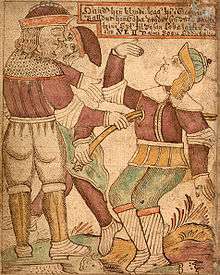Árni Magnússon Institute for Icelandic Studies
The Árni Magnússon Institute for Icelandic Studies (Stofnun Árna Magnússonar í íslenskum fræðum) is an institute of the Ministry of Education, Science and Culture of Iceland which conducts research in Icelandic and related academic studies, in particular the Icelandic language and Icelandic literature, to disseminate knowledge in those areas, and to protect and develop the collections that it possesses or those placed in its care. It is named after Árni Magnússon, a 17th-18th century collector of medieval Icelandic manuscripts.
The Árni Magnússon Institute (Icelandic: Stofnun Árna Magnússonar) was an academic institute located in Reykjavík, Iceland. The institute had the task of preserving and studying medieval Icelandic manuscripts containing Landnáma, Heimskringla and the Icelandic sagas. On September 1, 2006, this institute was merged with the Icelandic Language Institute, the University of Iceland Institute of Lexicography, the Sigurður Nordal Institute, and the Place-Name Institute of Iceland to create the current Árni Magnússon Institute for Icelandic Studies. It is a university institution with its own board and financing. The Minister of Education, Science and Culture appoints a five-member board for four-year terms. Three members are appointed according to nomination by the University Senate and two without nomination, with one of those two acting as chairman. The Minister appoints a director for five-year terms on the recommendation of the board.
Dr. Vésteinn Ólason was appointed director of the Institute of Icelandic Studies on September 12, 2006. Vésteinn had been the director of the Árni Magnússon Institute from May 1, 1999 until September 1, 2006, after which it was merged with four other institutes to create the Árni Magnússon Institute for Icelandic Studies. Professor Guðrún Nordal took over as director of the institute on March 1, 2009, appointed for a period of five years.
History

After Iceland received home rule from the Danish government in 1904, the Icelandic parliament (Alþingi) began to petition for the return to Iceland of at least a significant portion of the Arnamagnæan Manuscript Collection, the manuscripts and other documents collected in the late 17th and early 18th centuries by the Icelandic antiquarian and scholar Árni Magnússon. In 1927-28 four manuscripts and some 700 charters and other legal documents were returned to the Icelandic National Archives. In 1962 a special institute was set up under the name Handritastofnun Íslands (English: "Icelandic Manuscript Institute"). Ten years later, after the transfer of manuscripts from Copenhagen had begun in earnest, the laws concerning the institute were changed and it was renamed Stofnun Árna Magnússonar á Íslandi (generally referred to as Árnastofnun). It was administratively associated with the University of Iceland until 1 September 2006, when it merged with four other institutes in Iceland to create a larger independent institute of Icelandic studies, the Árni Magnússon Institute for Icelandic Studies.
Location
The institute is located in the Árnagarður building on the campus of the University of Iceland by Suðurgata in Reykjavík.
Manuscripts
The institute houses a number of historically and culturally important manuscripts, the bulk of them from the Arnamagnæan Manuscript Collection. Among these are:
- AM 113 fol (Íslendingabók)
- AM 371 4to (the Landnámabók)
- AM 738 4to
- GKS 1005 fol (the Flateyjarbók)
- GKS 2365 4to (Codex Regius of the Poetic Edda)
- GKS 2367 4to (Codex Regius of the Snorra-Edda)
- Icelandic Manuscript, SÁM 66
See also
- Arnamagnæan Institute, the institution in Copenhagen housing the remainder of the Árni Magnússon collection
References
External links
- (Icelandic) Árni Magnússon Institute’s Official Website
- (Icelandic) Online manuscript facsimiles
- (English) Árni Magnússon Institute
Coordinates: 64°08′20″N 21°57′05″W / 64.13889°N 21.95139°W
